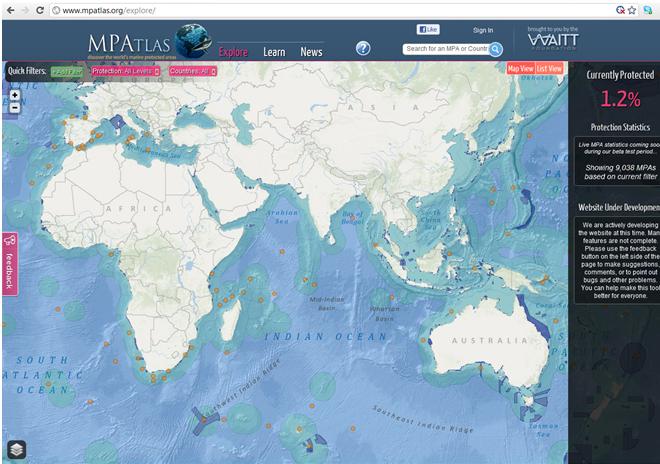Marine protected areas (MPA) are a conservation tool that sets aside part of the ocean to protect it for long-term conservation, similar to the way a state or national park functions on land. These MPAs are an effective way to preserve biodiversity by protecting ecosystems. But how are they utilized by people, and do they support human engagement? And, while conservation alone is important, will MPAs build climate resilience?
EDFish
Selected tag(s): MPAs
Science to Action: a ten-year review of California’s MPA Network
EDF Partner In Cuba Visits US for “Our Oceans” Conference (Part 2)

Dr. Fabián Pina Amargós is a first-rate marine scientist from Cuba, who has worked closely with EDF’s Oceans program for many years. Fabián has been a scientist with Cuba’s Center for Coastal Ecosystems Research for twenty years and was recently named director of the center.
Welcome back for Part 2 of our intern Shannon Switzer’s interview with Dr. Fabián Pina Amargós, as they discuss the marine scientist’s opinion on the effectiveness of MPA’s and ecotourism as conservation tools as well as his hopes for Cuba as a nation. Read the first part of the interview here.
SLS: Some people are skeptical that MPAs are effective in sustaining fisheries while protecting marine life. What have your studies shown you about the effectiveness of MPAs?
FPA: I think that of course, the controversial part is because nature is very variable. Sometimes you can have the results or the positive impacts of a management tool in a shorter time and sometimes it takes longer, which is dependent, for example, on the species you are trying to recover. So a species that has a short life cycle would have an impact of a no-take area faster, but if we are thinking tarpon, or goliath grouper or other species that live longer, you need to wait a longer time [to see the results].
But generally speaking, and especially where I am dealing in the Gardens, which is relevant for Cuba but also for other tropical places with similar ecosystems, we measured the results of the effect of the marine reserve. We found that after ten years of the declaration [of the MPA] the number of fish increased, the size of the fish are bigger and they are more abundant inside of the reserve. Also, they are not shy and are friendlier and allow you to get closer, so you can enjoy them more when you dive. But also, because the number has increased dramatically, we carried out an experiment and tested the spill-over effect, which is when the number of fish increases until it’s full inside, and they need to move outside. It’s not a random movement, it’s basically a density-dependent kind of movement, cause it’s crowded inside the protected area, and then they just spill over the boundaries.
Then the fishery grounds benefit from that, and you can fish outside. We’ve proved that [with our research], but now fishermen are saying most of the fish they are catching now are coming from the reserve. So now the reserves are gaining support by, not all of the fishermen, but many of them. At the beginning the vast majority of them were opposed to the reserve, and it’s a normal reaction of human behavior—you are preventing me from using a fishing ground that I’ve been using forever and my father and my grandfather and my grand grandfather were fishing on—but they realize now that this is a good tool. Read More
MPAtlas Provides New Tool to Learn about Marine Protected Areas
The Marine Conservation Institute, in partnership with the Waitt Foundation, has developed an online digital atlas that assembles information on marine protected areas (MPAs) around the world. This is a valuable tool that provides the ability to explore sites and characteristics of existing and proposed MPAs. When developed with careful consideration of fishing communities, MPAs have the potential to accelerate recovery of fish populations, increase ecosystem resilience and provide data for stock assessments and catch limit setting. Learning about existing MPAs and their impacts can help inform the design and implementation of future sites, and hopefully improve the ability of MPAs to provide direct ecosystem and fishery benefits.
Cabinet of Belize Approves Catch Shares in Belize’s Network of Marine Protected Areas

Catch shares team in Belize from Environmental Defense Fund, Wildlife Conservation Society, and Belize Fisheries Department.
“Fish Forever” – the motto of Belize’s fishermen. Last week the Government of Belize in partnership with Environmental Defense Fund (EDF) took a major step towards fulfilling that vision with a vote by Belize’s cabinet to authorize the implementation of catch shares in its network of marine protected areas.
“Belize’s decision will protect the country’s magnificent Mesoamerican Reef and promote the vitality of its fishing industry,” said Larry Epstein, Mesoamerican Reef Program Manager for EDF, “This substantially adds to the growing list of successful conservation measures Belize is using to preserve its oceans for future generations.”
As a first step, the Belize Fisheries Department will implement their design for TURFs and catch limits for spiny lobster in 2011 and 2012 in Glover’s Reef and Port Honduras Marine Reserves. Belize has already taken the first steps for allocating access to TURFs, creating a monitoring regime, and creating committees of fishermen to participate in the implementation and management of catch shares.
“Catch shares will assist in enforcing marine laws and ensure that fishermen are part and parcel of the enforcement, and respected as custodians because it will be part of their livelihoods that they will be protecting.”
– Hon. Rene Montero, Belize Minister of Agriculture, Fisheries and Cooperatives
In 2009 EDF created a partnership between the Government of Belize Fisheries Department, Wildlife Conservation Society, and the leading Belizean conservation NGO – the Toledo Institute for Development and Environment (TIDE). Our coalition achieved this milestone in Belize through an education campaign that engaged fishermen, policy makers, elected officials, and government managers of marine reserves. EDF’s team of economists, scientists, and catch shares experts built Belize’s technical capacity for catch shares and helped develop the catch share design – including Rod Fujita, Kate Bonzon, Laura Rodriguez, Jake Kritzer, Doug Rader, Tom Lalley, and Tesia Love. The Government of Belize has stated a vision for catch shares in all marine reserves, and for the commercial lobster fishery.
Fishermen in Belize understand first-hand and have been advocating catch shares since EDF, WCS, and TIDE began working in their communities. According to one fisherman from Placencia, a fishing community in southern Belize, “Every year for the past ten years we have had a decline in lobster production. That is due to, I think, to overfishing and a general decline in product itself.” Now Belize and its fishermen have a tool at their disposal that protects its oceans, while at the same time supporting the livelihoods and food security for the people that depend on its resources.












